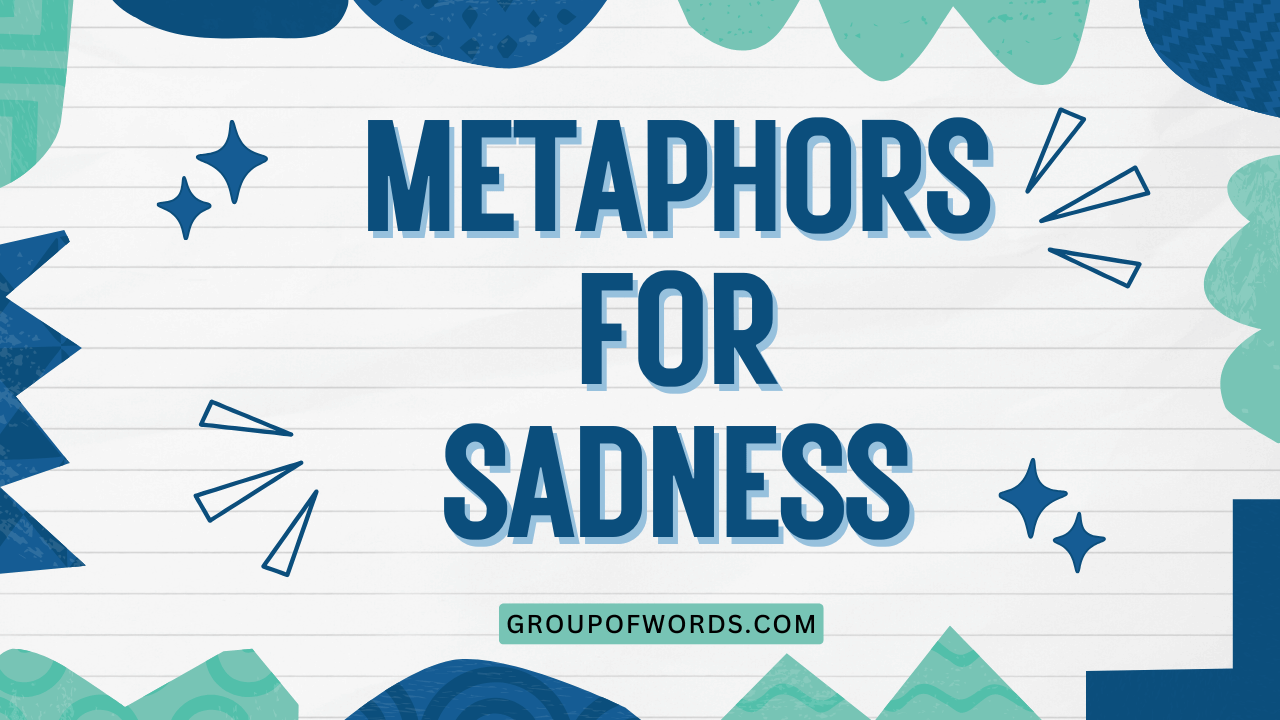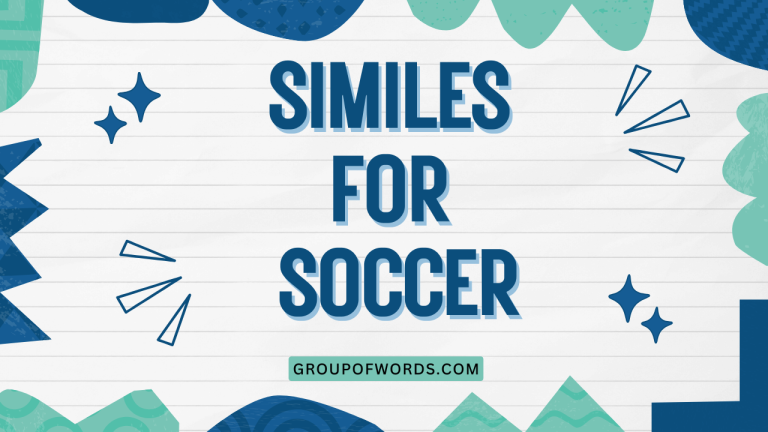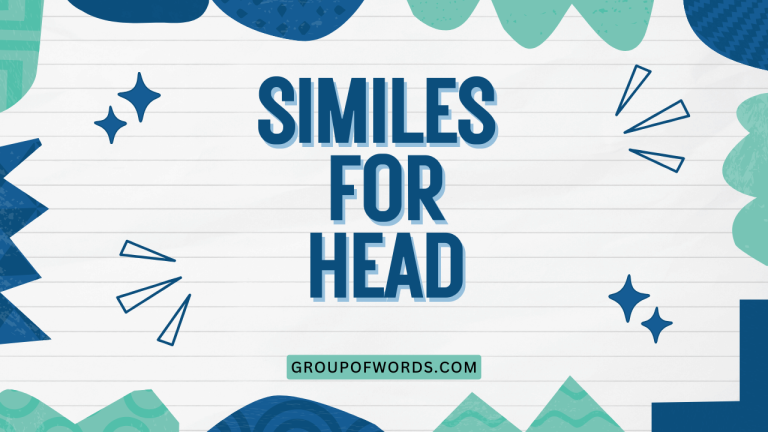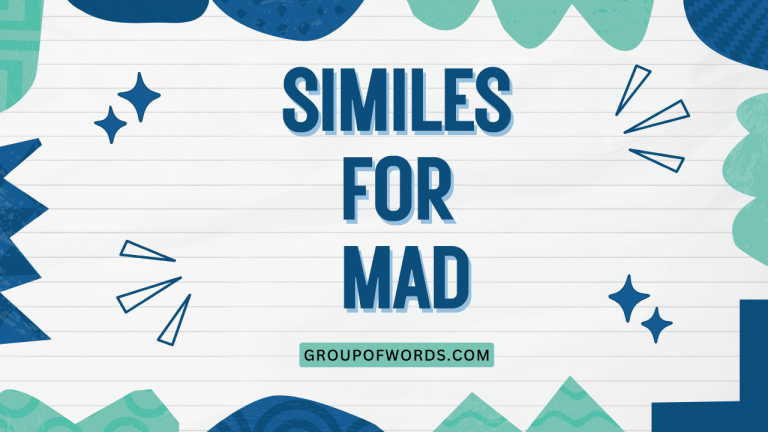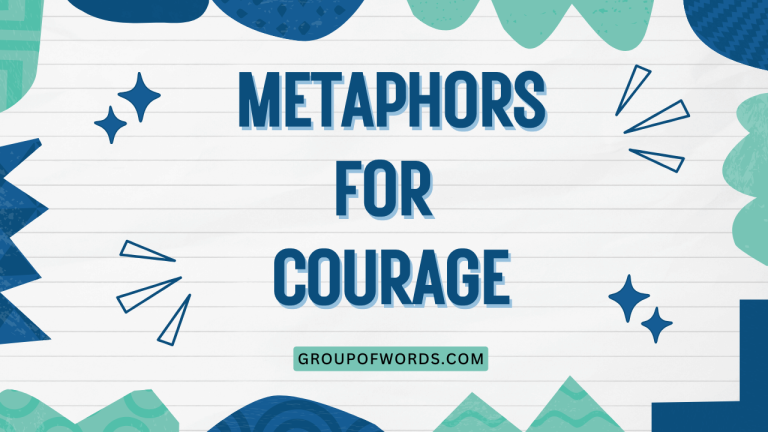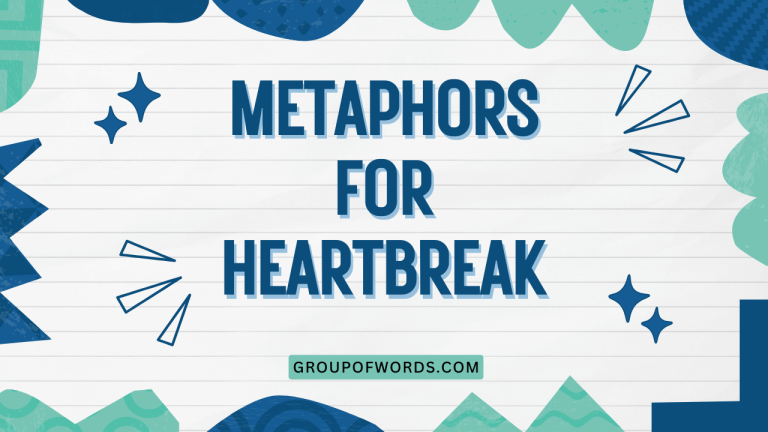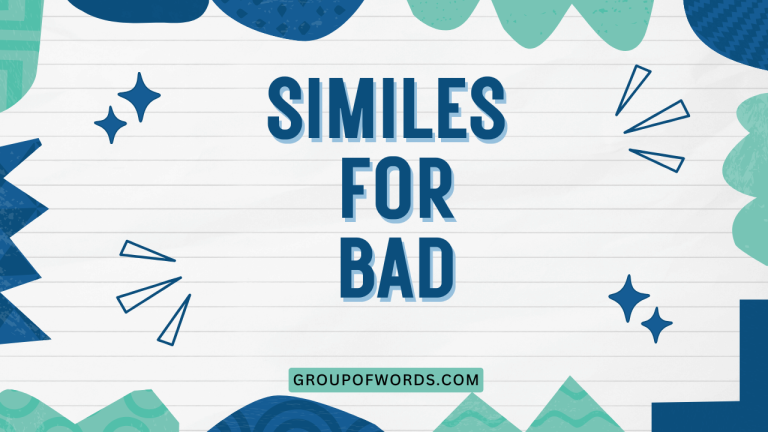Metaphors for Sadness: Expressing Sorrow in English
Sadness, a universal human emotion, is often difficult to articulate directly. Metaphors provide a powerful tool to express the depth and complexity of sorrow, allowing us to connect with others on an emotional level.
Understanding these metaphors enhances our comprehension of English literature, poetry, and everyday conversation. This article explores various metaphors for sadness, offering examples, explanations, and exercises to help you master their usage.
This guide is beneficial for English language learners, writers, and anyone interested in expanding their emotional vocabulary.
This comprehensive guide explores the landscape of metaphors used to describe sadness. We will delve into the various types of metaphors, providing countless examples and usage guidelines.
Furthermore, we will address common mistakes and provide practical exercises to solidify your understanding. Whether you are an English language learner, a writer seeking to enrich your prose, or simply someone interested in the nuances of language, this article offers a wealth of knowledge and practical tools.
Table of Contents
- Introduction
- Definition of Metaphor for Sadness
- Structural Breakdown
- Types and Categories of Sadness Metaphors
- Examples of Metaphors for Sadness
- Usage Rules for Metaphors of Sadness
- Common Mistakes
- Practice Exercises
- Advanced Topics
- FAQ
- Conclusion
Definition of Metaphor for Sadness
A metaphor for sadness is a figure of speech that describes the emotion of sadness by comparing it to something else that shares similar characteristics. Unlike similes, which use “like” or “as” to make comparisons, metaphors directly equate sadness to another concept, creating a more vivid and impactful image. These metaphors help us understand and express the often-intangible feeling of sadness in a relatable and evocative way. The function of these metaphors is to deepen emotional expression and provide alternative ways to conceptualize sadness.
Metaphors function by transferring qualities from one thing to another. In the context of sadness, this means taking attributes associated with something concrete (like darkness or weight) and applying them to the abstract emotion of sadness.
This process allows us to bypass the limitations of literal language and tap into a richer, more imaginative realm of expression. For instance, instead of simply stating “I am sad,” one might say “A dark cloud hangs over me,” effectively conveying the heaviness and oppressiveness of sadness through a metaphorical image.
Structural Breakdown
Metaphors for sadness, like all metaphors, consist of two primary elements: the tenor and the vehicle. The tenor is the subject being described (in this case, sadness), and the vehicle is the object or concept to which sadness is being compared. The connection between the tenor and the vehicle is based on shared characteristics or associations. Understanding this structure helps in both interpreting and creating effective metaphors.
For example, in the metaphor “Sadness is a heavy cloak,” the tenor is sadness, and the vehicle is a “heavy cloak.” The shared characteristic is the feeling of being weighed down or burdened. The effectiveness of a metaphor often depends on how clearly and powerfully this shared characteristic is conveyed.
A well-constructed metaphor resonates with the audience, creating a deeper understanding of the emotion being expressed.
Let’s break down the structure further:
- Tenor (Subject): The emotion of sadness.
- Vehicle (Object of Comparison): Something tangible or relatable (e.g., a cloud, a weight, darkness).
- Ground (Shared Characteristic): The common attribute or feeling that connects the tenor and the vehicle (e.g., heaviness, oppressiveness, gloominess).
Types and Categories of Sadness Metaphors
Metaphors for sadness can be categorized based on the type of imagery they employ. Here are some common categories:
Sadness as a Physical Burden
These metaphors describe sadness as something heavy or difficult to carry, emphasizing the feeling of being weighed down. This category effectively conveys the oppressive nature of sadness.
Sadness as Weather
These metaphors use weather phenomena like rain, storms, or fog to represent the emotional state of sadness. They are particularly effective in depicting the transient and pervasive nature of sorrow.
Sadness as Color
These metaphors associate sadness with specific colors, typically dark or muted tones, to evoke a sense of gloom and despondency. They provide a simple yet powerful way to convey emotional tone.
Sadness as Water
These metaphors use water imagery, such as tears, oceans, or floods, to represent the outpouring and overwhelming nature of sadness. They often highlight the intensity and uncontrollability of grief.
Sadness as Darkness or Absence of Light
These metaphors equate sadness with darkness or a lack of light, symbolizing hopelessness and despair. They are particularly effective in conveying the feeling of being lost or trapped in sorrow.
Sadness as Weight or Pressure
This category captures the feeling of being burdened or crushed by sadness, emphasizing its oppressive and debilitating effects. These metaphors effectively convey the physical and emotional toll of sorrow.
Sadness as Emptiness or Void
These metaphors describe sadness as a feeling of hollowness or absence, highlighting the lack of joy and fulfillment. They are particularly effective in representing a sense of loss or bereavement.
Sadness as Sickness or Disease
These metaphors portray sadness as something that infects or weakens, emphasizing its debilitating and pervasive nature. They often convey the feeling of being consumed or overwhelmed by sorrow.
Examples of Metaphors for Sadness
Here are some examples of metaphors for sadness, categorized by type:
Table 1: Sadness as a Physical Burden
This table showcases examples where sadness is portrayed as a physical weight or burden, emphasizing the oppressive nature of the emotion.
| Metaphor | Explanation |
|---|---|
| Sadness is a heavy cloak. | Sadness weighs down the person like a heavy garment. |
| Grief is a stone in my heart. | Grief feels like a solid, unyielding weight in the chest. |
| Sorrow is a leaden weight on my shoulders. | Sorrow feels like a heavy burden to carry. |
| Despair is a ball and chain. | Despair restricts and imprisons the person. |
| My heart carries a ton of sorrow. | The person feels overwhelmed by sadness. |
| The weight of sadness crushed her spirit. | Sadness has a debilitating effect on her morale. |
| He bore the cross of grief with silent fortitude. | He carried the burden of grief with strength and resilience. |
| Her sadness was a burden she could barely manage. | The sadness was an overwhelming challenge for her. |
| The memory of loss is a heavy anchor. | The memory weighs down the person, preventing them from moving forward. |
| His grief was a mountain he had to climb. | Grief presented a difficult and arduous challenge. |
| She felt the weight of the world on her shoulders. | Her sadness made her feel responsible for everything. |
| The sorrow was a millstone around his neck. | The sorrow was a constant and debilitating burden. |
| He carried the burden of regret for years. | He was weighed down by his remorse. |
| Her heart was burdened with unspoken grief. | Her sadness was hidden but still heavy. |
| His sadness felt like a physical ache. | His emotional pain manifested as physical discomfort. |
| She was weighed down by the enormity of her loss. | The magnitude of her loss felt crushing. |
| The pain of his absence was a constant weight. | His absence brought ongoing sadness and heaviness. |
| He felt like he was carrying the grief of the entire world. | His sadness was all-encompassing and overwhelming. |
| Her sadness was a heavy chain binding her to the past. | Her sadness prevented her from moving forward. |
| The weight of her grief pressed down on her chest. | Her sadness felt like a physical pressure. |
| He felt the oppressive weight of his sadness. | His sadness felt like a heavy and suffocating burden. |
| Her sorrow was a heavy burden to bear. | Her sadness was difficult to endure. |
| The weight of the bad news crushed him. | The bad news was a heavy blow that left him feeling defeated. |
| He was burdened by the weight of his responsibilities and sadness. | He felt overwhelmed by his duties and emotional pain. |
| She carried the weight of her past traumas. | Her past traumas continued to burden and affect her. |
Table 2: Sadness as Weather
This table illustrates how weather-related metaphors are used to describe the fluctuating and pervasive nature of sadness.
| Metaphor | Explanation |
|---|---|
| Sadness is a dark cloud. | Sadness obscures joy and brings gloom. |
| Tears are the rain of my sorrow. | Tears represent the outpouring of sadness. |
| Grief is a storm in my soul. | Grief feels like a turbulent and destructive force within. |
| Despair is a long winter. | Despair feels like a prolonged period of coldness and hardship. |
| My heart is shrouded in fog. | The person feels confused and disoriented by sadness. |
| A shadow of sadness fell over her face. | Her sadness was visible and noticeable. |
| The clouds of grief gathered in his eyes. | Tears were forming as a result of his sadness. |
| Her spirit was dampened by sorrow. | Her morale was lowered by sadness. |
| A wave of sadness washed over him. | He was suddenly overwhelmed by sadness. |
| The sun of my happiness has set. | Joy has disappeared from the person’s life. |
| She was weathering the storm of grief. | She was enduring a difficult period of mourning. |
| The fog of despair clouded his judgment. | Despair made it difficult for him to think clearly. |
| His heart was a barren wasteland. | He felt emotionally empty and desolate. |
| The rain of tears streamed down her face. | She was crying profusely. |
| The storm of emotions raged within him. | He was experiencing a turbulent mix of feelings. |
| Her sadness was like a constant drizzle. | Her sadness was persistent and unrelenting. |
| He felt like he was drowning in a sea of sorrow. | He was overwhelmed by his sadness. |
| The dark clouds of depression loomed over him. | He was experiencing a period of deep sadness and hopelessness. |
| Her spirit was withered by the cold winds of despair. | Her morale was diminished by her despair. |
| The sunshine of her smile disappeared, replaced by the rain of tears. | Her happiness was replaced by sadness and crying. |
| He felt like he was walking through a perpetual twilight. | He felt like he was living in a state of constant sadness and dimness. |
| Her sadness was like a thick fog, obscuring her vision. | Her sadness made it difficult for her to see things clearly. |
| The storm of grief left her feeling battered and broken. | The intense sadness left her emotionally damaged. |
| He was caught in a downpour of despair. | He was suddenly and intensely overwhelmed by despair. |
| Her heart was a frozen tundra, devoid of warmth. | She felt emotionally cold and unfeeling. |
Table 3: Sadness as Color
This table demonstrates how colors are used metaphorically to represent the mood and tone of sadness.
| Metaphor | Explanation |
|---|---|
| Sadness is blue. | Sadness is associated with the color blue, representing melancholy. |
| Grief is painted in shades of gray. | Grief is associated with dullness and lack of vibrancy. |
| Despair is a black canvas. | Despair is associated with darkness and hopelessness. |
| My world has turned gray. | Joy and color have disappeared from the person’s life. |
| Her heart was filled with a dark hue of sadness. | Her sadness was deep and intense. |
| Life felt monochrome without her. | Life lacked color and vibrancy after her absence. |
| The room was filled with a somber gray light. | The atmosphere was depressing and gloomy. |
| Her sadness cast a pallid hue over everything. | Her sadness affected her perception of everything around her. |
| He saw the world through a veil of gray. | He perceived everything as dull and lifeless. |
| The vibrant colors of life had faded to black. | Joy and excitement had disappeared from his life. |
| Her heart was tinged with a shade of melancholy. | She felt a subtle but pervasive sadness. |
| His world lost its color after the loss. | Life felt dull and meaningless after the loss. |
| She felt a deep, indigo sadness. | Her sadness was profound and intense. |
| The room was bathed in a depressing, muted light. | The atmosphere was somber and uninviting. |
| His life felt like a faded photograph. | His life lacked vibrancy and clarity. |
| Her sadness was a dark stain on her soul. | Her sadness had a lasting and damaging effect. |
| Everything seemed to be cast in shades of sorrow. | Every aspect of life was affected by sadness. |
| His world turned a bleak, desolate gray. | His life felt empty and without hope. |
| Her heart was a palette of muted colors. | Her emotions were subdued and lacking vibrancy. |
| The landscape of her emotions was painted in somber hues. | Her feelings were characterized by sadness and melancholy. |
| He felt like he was living in a black and white movie. | His life lacked excitement and vibrancy. |
| Her sadness was a deep, dark purple, like a bruise on her heart. | Her sadness was painful and damaging. |
| The world seemed to lose its sparkle, turning a dull gray. | Life felt uninteresting and lifeless. |
| He was enveloped in a blue mood. | He was feeling sad and melancholy. |
| Her heart was cloaked in a dark, somber color. | She felt deeply saddened and gloomy. |
Table 4: Sadness as Water
This table explores metaphors that use water-related imagery to convey the overwhelming and fluid nature of sadness.
| Metaphor | Explanation |
|---|---|
| Sadness is a sea of tears. | Sadness manifests as a large quantity of tears. |
| Grief is a flood. | Grief is overwhelming and destructive. |
| Despair is a deep ocean. | Despair feels vast and unending. |
| My heart is drowning in sorrow. | The person feels overwhelmed by sadness. |
| A river of tears flowed down her face. | She was crying continuously and profusely. |
| He was swept away by a tide of grief. | He was overwhelmed by intense sadness. |
| Her eyes were pools of sadness. | Her eyes reflected her deep sorrow. |
| The floodgates of her emotions opened. | She began to cry uncontrollably. |
| He felt lost in a sea of despair. | He felt overwhelmed and hopeless. |
| Her heart was an ocean of sorrow. | Her sadness was vast and deep. |
| Tears streamed down her face like a waterfall. | She was crying intensely and continuously. |
| He was submerged in a wave of grief. | He was completely overcome by sadness. |
| Her sadness was a deep, still lake. | Her sadness was profound and unchanging. |
| The tears welled up in her eyes like a spring. | Tears were forming and about to overflow. |
| He was adrift in a sea of loneliness. | He felt isolated and lost. |
| Her grief was a relentless current pulling her under. | Her grief was constantly threatening to overwhelm her. |
| She felt like she was drowning in a sea of despair. | She was overwhelmed by feelings of hopelessness. |
| His heart was a reservoir of unspoken tears. | He was holding back a great amount of sadness. |
| Her sadness was a deep, dark abyss. | Her sadness was profound and seemingly bottomless. |
| The waves of grief crashed over him. | He was repeatedly overwhelmed by intense sadness. |
| He was lost in a whirlpool of emotions. | He was confused and overwhelmed by his feelings. |
| Her sadness was a vast, uncharted ocean. | Her sadness was deep and mysterious. |
| The tears flowed freely, washing away the pain. | Crying provided a release from the emotional pain. |
| He was submerged in a tidal wave of sorrow. | He was completely overwhelmed by his sadness. |
| Her heart was a wellspring of unending grief. | She experienced a continuous and inexhaustible source of sadness. |
Table 5: Sadness as Darkness or Absence of Light
This table showcases metaphors that use imagery of darkness and light to depict the feelings of despair and hopelessness associated with sadness.
| Metaphor | Explanation |
|---|---|
| Sadness is darkness. | Sadness is associated with a lack of light and joy. |
| Grief is a long night. | Grief feels like a prolonged period of hardship and despair. |
| Despair is a bottomless pit. | Despair feels like an endless and inescapable void. |
| My heart is shrouded in darkness. | The person feels emotionally isolated and hopeless. |
| A shadow of sadness fell over her. | Her sadness was visible and pervasive. |
| The light has gone out of his eyes. | He has lost his joy and enthusiasm. |
| Her spirit was dimmed by sorrow. | Her morale was lowered by sadness. |
| He felt like he was living in the shadows. | He felt marginalized and unseen. |
| Her heart was a dark and empty space. | She felt emotionally hollow and desolate. |
| The sun of my life has set. | Joy and happiness have disappeared from the person’s life. |
| She was lost in the darkness of despair. | She felt overwhelmed and hopeless. |
| His heart was a black hole of sadness. | His sadness was all-consuming and seemed to have no end. |
| She felt like she was walking in perpetual twilight. | She felt like she was living in a state of constant sadness and dimness. |
| The world seemed to fade into darkness. | Everything felt bleak and hopeless. |
| His life was a long, dark tunnel. | He felt like he was enduring a prolonged period of hardship. |
| Her hope flickered and died in the darkness of her grief. | Her optimism was extinguished by her sadness. |
| The darkness of despair enveloped him. | He was completely overcome by feelings of hopelessness. |
| His heart was a barren wasteland, devoid of light. | He felt emotionally empty and desolate. |
| Her sadness was a deep, dark abyss. | Her sadness was profound and seemingly bottomless. |
| The light in her eyes had been extinguished by grief. | She had lost her joy and vitality due to sadness. |
| He felt like he was living in a perpetual night. | He felt like he was constantly surrounded by sadness and despair. |
| Her sadness was a dark, heavy cloud that blocked out the sun. | Her sadness prevented her from experiencing joy and happiness. |
| The world seemed to lose its sparkle, becoming a dull, dark place. | Life felt uninteresting and lifeless. |
| He was consumed by a darkness he couldn’t escape. | He felt trapped in his sadness. |
| Her heart was cloaked in a dark, somber shadow. | She felt deeply saddened and gloomy. |
Usage Rules for Metaphors of Sadness
When using metaphors for sadness, it’s important to ensure they are appropriate and effective. Here are some usage rules:
- Clarity: The metaphor should be easily understood. Avoid obscure or overly complex comparisons.
- Relevance: The vehicle should have a clear connection to the tenor (sadness). The shared characteristic should be evident.
- Originality: While common metaphors can be effective, strive for originality to create a more impactful and memorable image.
- Consistency: Maintain consistency in your metaphorical language. Avoid mixing metaphors that create conflicting images.
- Context: Consider the context in which you are using the metaphor. Is it appropriate for the audience and the situation?
Common Mistakes
Here are some common mistakes to avoid when using metaphors for sadness:
- Mixed Metaphors: Combining metaphors that create illogical or contradictory images. Incorrect: “The sea of grief was a heavy cloak.” Correct: “The sea of grief washed over me.”
- Clichés: Overusing common metaphors that have lost their impact. Instead of “feeling blue,” try “a dark cloud hung over her.”
- Overly Complex Metaphors: Using metaphors that are too complicated or obscure. Keep the comparison simple and relatable.
- Inappropriate Tone: Using metaphors that are insensitive or offensive in certain contexts. Be mindful of the audience and situation.
Here’s a table showcasing correct and incorrect usage.
| Incorrect | Correct | Explanation |
|---|---|---|
| My sadness is a brick wall of sunshine. | My sadness is a brick wall. | Mixed metaphor; brick wall does not equate to sunshine. |
| I am feeling blue like everyone else. | A wave of melancholy washed over me. | “Feeling blue” is a cliché; the corrected sentence is more evocative. |
| Her sorrow was a quantum entanglement of existential angst. | Her sorrow was a deep well. | The incorrect sentence is overly complex; the correction is simpler and clearer. |
| His grief was a hilarious joke. | His grief was a crushing blow. | The incorrect sentence is inappropriate in tone; grief is not humorous. |
| Her heart was a garden of sorrow, watered by the sun. | Her heart was a garden of sorrow, watered by tears. | Inconsistent imagery; sun does not water a garden of sorrow, tears do. |
Practice Exercises
Test your understanding with these practice exercises:
Exercise 1: Identifying Metaphors
Identify the metaphor in each sentence and explain what it means.
| Question | Answer |
|---|---|
| 1. His heart was a lead weight in his chest. | Metaphor: “lead weight.” Meaning: His sadness felt heavy and oppressive. |
| 2. The rain of tears streamed down her face. | Metaphor: “rain of tears.” Meaning: She was crying profusely. |
| 3. Her spirit was a withered flower. | Metaphor: “withered flower.” Meaning: Her morale was diminished by sadness. |
| 4. Grief is a storm raging within him. | Metaphor: “storm raging.” Meaning: He was experiencing intense and turbulent sadness. |
| 5. The darkness of despair enveloped her. | Metaphor: “darkness of despair.” Meaning: She was completely overcome by hopelessness. |
| 6. His sadness was a deep, dark abyss. | Metaphor: “deep, dark abyss.” Meaning: His sadness was profound and seemingly bottomless. |
| 7. She felt like she was drowning in a sea of sorrow. | Metaphor: “drowning in a sea of sorrow.” Meaning: She was overwhelmed by her sadness. |
| 8. The clouds of grief gathered in his eyes. | Metaphor: “clouds of grief.” Meaning: He was about to cry. |
| 9. Her heart was a frozen tundra, devoid of warmth. | Metaphor: “frozen tundra.” Meaning: She felt emotionally cold and unfeeling. |
| 10. His sadness was a heavy chain binding him to the past. | Metaphor: “heavy chain.” Meaning: His sadness prevented him from moving forward. |
Exercise 2: Completing the Metaphor
Complete the following sentences using appropriate metaphors for sadness.
| Question | Answer |
|---|---|
| 1. His heart was as heavy as ____. | ____ a stone. |
| 2. Her sadness was like ____. | ____ a dark cloud hanging over her. |
| 3. The tears flowed like ____. | ____ a river. |
| 4. Grief felt like ____. | ____ a crushing weight. |
| 5. Despair was ____. | ____ a long, dark night. |
| 6. Her spirit was as fragile as ____. | ____ a broken vase. |
| 7. His hope had ____. | ____ withered and died. |
| 8. The world seemed ____. | ____ painted in shades of gray. |
| 9. Her smile was replaced by ____. | ____ a veil of sorrow. |
| 10. His heart was a ____. | ____ a barren wasteland. |
Exercise 3: Creating Your Own Metaphors
Create your own original metaphors for sadness based on the following prompts.
| Prompt | Example Answer |
|---|---|
| 1. Describe sadness as a place. | Sadness is a desolate island, far from any shore. |
| 2. Describe sadness as an object. | Sadness is a tarnished mirror reflecting only imperfections. |
| 3. Describe sadness as a sound. | Sadness is a mournful cello echoing in an empty concert hall. |
| 4. Describe sadness as a taste. | Sadness is a bitter lemon lingering on the tongue. |
| 5. Describe sadness as a texture. | Sadness is a rough wool blanket on a cold winter night. |
| 6. Describe sadness as a journey. | Sadness is a winding road leading to nowhere. |
| 7. Describe sadness as an animal. | Sadness is a caged bird that no longer sings. |
| 8. Describe sadness as a memory. | Sadness is an old photograph, faded and worn. |
| 9. Describe sadness as a feeling. | Sadness is a dull ache that never quite disappears. |
| 10. Describe sadness as a story. | Sadness is an unfinished book with a tragic ending. |
Advanced Topics
For advanced learners, consider exploring these more complex aspects of metaphors for sadness:
- Extended Metaphors: Developing a single metaphor over an entire poem or story.
- Subverted Metaphors: Using metaphors in unexpected or ironic ways.
- Cultural Variations: Exploring how metaphors for sadness differ across cultures.
- The Cognitive Science of Metaphor: Investigating the psychological processes underlying metaphorical thinking.
FAQ
Here are some frequently asked questions about metaphors for sadness:
- What is the difference between a metaphor and a simile?
A metaphor directly equates two things, while a simile uses “like” or “as” to make a comparison. For example, “Sadness is a dark cloud” (metaphor) vs. “Sadness is like a dark cloud” (simile). The metaphor is a stronger, more direct comparison.
- Why are metaphors effective in expressing sadness?
Metaphors provide a way to express the intangible and complex nature of sadness by relating it to something more concrete and relatable. This allows for a deeper emotional
expression and understanding.
- How can I improve my use of metaphors for sadness?
Practice, read widely, and pay attention to how other writers use metaphors. Experiment with different types of imagery and focus on creating clear and evocative comparisons.
- Are there any metaphors for sadness that should be avoided?
Avoid clichés and metaphors that are insensitive or offensive. Be mindful of your audience and the context in which you are using the metaphor.
Conclusion
Metaphors for sadness are a powerful tool for expressing the complexities of human emotion. By understanding the structure, types, and usage rules of these metaphors, you can enhance your ability to communicate effectively and connect with others on a deeper level.
Whether you are a writer, a language learner, or simply someone interested in exploring the nuances of language, mastering metaphors for sadness will enrich your understanding and appreciation of the English language.
